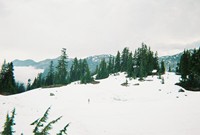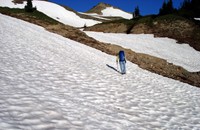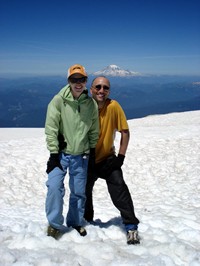"I quit," Maiu told me.
We had endured over 200 miles filled with snow, swollen icy rivers, and no footprints. Her feet were a disaster with blisters and massive swelling all testifying to the monumental effort she put forth to hike everyday from 4am to 9pm.
Although I had warned her that the first 2 weeks would be brutal, it is hard to prepare for such an intense undertaking. Indeed, fear had been pumping through her veins nonstop for 2 weeks. She feared:
- Being attacked by a bear
- Plunging down an ice covered mountain
- Being swept away by a fast moving river
- Getting lost and starving

Even after grueling 17 hour days she found it hard to sleep, afraid of a midnight visitor.
The snow was thinning out after 200 miles and I was hoping the spectacular views north of Snoqualmie would remind Maiu the joys of being on the trail. Instead we spent the last 25 miles climbing thousands of feet, slogging through dangerously steep snow banks, and being completely shrouded in fog all day.
"I am not going back to the trail," Maiu told me.
I said, "Let's just rest a few..."
"Don't even try to convince me, Francis," she interrupted. "I am not going back," she repeated.
However, after 6 days of rest in Seattle and almost no salesmanship on my part, Maiu was ready to return to the PCT.
Of course, she had her list of demands: an MP3 player, a Pocketmail device, and a camera. It was one pound of gear, but I ditched my camcorder, so the net weight gain was negligible.
The rest of Washington was spectacular, warm, and mostly snow free. The two highlig hts included:
hts included:
- Goat Rocks Wilderness, which dazzled us with its alpine scenery.
- Mt. Adams, which the PCT just skirts around, but we took a detour and climbed the 12,240 foot summit. Although Maiu had her ice axe and boots, I just had sneakers. We were dehydrated, but she dealt with it better than I. She zoomed pass a dozen climbers who had started well before her and was the first to reach the top. I crawled in 3 hours later.
We soon crossed the Bridge of the Gods, which spans the Columbia River, the lowest point on the PCT. With that crossing we entered Oregon.
We happily turned our backs to Washington's snowfields and sadly faced the mosquito infested state of Oregon.
We bid farewell to a sun that rarely set, and prepared for shorter days.
We kissed goodbye the state with no income tax and said hello to the state with no sales tax.
One state down, two to go.
One month on the trail, three to go.
500 miles walked, 2150 to go.
Sponsor spotlight: Gossamer Gear
I am always trying to find backpacking gear that lets me do more with less weight. Gossamer Gear excels in this. They not only make the best light backpacks in the world, they have other cool gea
- G5 Backpack: this is my dream pack. Lots of capacity, a hip belt, 3 side pockets, no zippers, and only half a pound. It achieves this feather weight by using waterproof spinnaker cloth. However, I wanted something a bit more rugged for this four month hike. So they sent me a prototype of the G5, made of silicon impregnated nylon, a tougher fabric than spinnaker. It's just 2 ounces heavier, but better able to withstand my abuse. After my successful testing, they are putting it into production.
- Uberlight Whisper Backpack: Maiu uses this pack, perhaps the lightest in existence. With a hip belt, it weighs just 5 ounces; without it, it comes in at simply 3.4 ounces. I thought my old backpack was ultra light at 14 ounces The Whisper sets a new standard. With over 2,000 cubic inches, it has plenty of capacity for Maiu's needs. Although it is very delicate, it has lasted over 500 miles with just a little wear and tear.
- SwinnTwinn Tarp: Tents are overrated. I have always used GoLite's 1 pound, 2 person tarp. However, when Gossamer came up with a 2 person tarp at half the weight, I had to test it. It's so simple to setup a taut pitch with just 4 guy lines. The tarp, made of spinnaker, is the best I've ever seen.
- Bug Canopy: At 3.5 ounces, this ingenious bug net provides significant protection at a minimal weight penalty. For 100% protection both Gossamer and GoLite provide excellent options.
- Groundsheet: I used to use Space Blankets as a ground sheet. Although they are the lightest option, they are so delicate that fall apart after a week of roughing it. They are less than $5, but that cost can add up in a thru-hike. Gossamer makes a groundsheet that is almost as light yet much tougher. I plan to use one for the 4 month backpacking adventure.
Check out their awesome stuff at http://www.gossamergear.com.
8/3/2006






